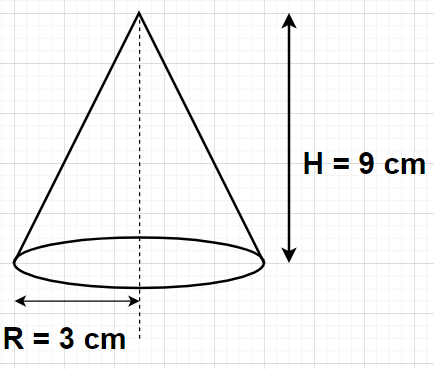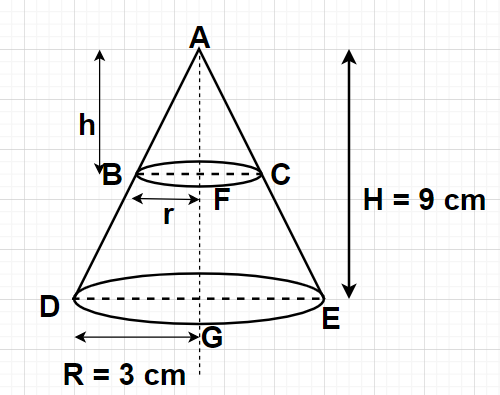
The height of a cone and the radius of its base are respectively 9 and 3 cm. The cone is cut by a plane parallel to its base so as to divide it into two parts. The volume of frustum of cone is 44 ${\text{c}}{{\text{m}}^3}$, then what is the radius of upper circular of frustum (Use $\pi = \dfrac{{22}}{7}$) ?
\[
{\text{A}}{\text{. }}\sqrt[3]{{12}}{\text{ cm}} \\
{\text{B}}{\text{. }}\sqrt[3]{{13}}{\text{ cm}} \\
{\text{C}}{\text{. }}\sqrt[3]{6}{\text{ cm}} \\
{\text{D}}{\text{. }}\sqrt[3]{{20}}{\text{ cm}} \\
\]




Answer
593.4k+ views
Hint- Here, we will proceed by developing a relation between the height and the radius of the smaller cone obtained after the original cone is cut by a plane. This is achieved with the help of the concept of similar triangles.
Complete step by step answer:
Given, Height of the cone, H = 9 cm
Radius of the base of the cone, R = 3 cm
Now, this cone is cut by a plane parallel to its base so as to divide this original cone into a smaller cone and a frustum. Let the radius of the smaller (upper) circular end of the frustum be r cm and the height of the smaller cone obtained be h cm.
The radius of the larger (lower) circular end of frustum is equal to the radius of the original cone i.e., R = 3 cm
Height of frustum = (H – h) cm = (9-h) cm
In triangles ABC and ADE,
$\angle {\text{A}} = \angle {\text{A}}$ [Common angle in both the triangles]
$\angle {\text{ABC}} = \angle {\text{ADE}}$ [Corresponding angles (because BC is parallel to DE) are equal in measure]
$\angle {\text{ACB}} = \angle {\text{AED}}$ [Corresponding angles (because BC is parallel to DE) are equal in measure]
By AAA (Angle-Angle-Angle) similarity rule, we can say that the triangles ABC and ADE are similar to each other i.e., $\vartriangle {\text{ABC}} \sim \vartriangle {\text{ADE}}$.
For any two similar triangles, the ratio of their corresponding dimensions are always equal.
Using the above concept for the two similar triangles i.e., ABC and ADE, we have
$
\Rightarrow \dfrac{{{\text{AF}}}}{{{\text{AG}}}} = \dfrac{{{\text{BF}}}}{{{\text{DG}}}} \\
\Rightarrow \dfrac{h}{H} = \dfrac{r}{R} \\
\Rightarrow \dfrac{h}{9} = \dfrac{r}{3} \\
\Rightarrow h = \dfrac{{9r}}{3} \\
\Rightarrow h = 3r \\
$
Since, volume of any cone is given by
Volume of the cone = $\dfrac{1}{3}\pi {\left( {{\text{Base radius}}} \right)^2} \times \left( {{\text{Height}}} \right)$
As, we know that volume of the frustum will be given by
Volume of frustum = Volume of original cone – Volume of the smaller cone
$ \Rightarrow $ Volume of frustum = $\dfrac{1}{3}\pi {\left( R \right)^2}\left( H \right) - \dfrac{1}{3}\pi {\left( r \right)^2}\left( h \right)$
By putting R = 3 cm, H = 9 cm, h = 3r and $\pi = \dfrac{{22}}{7}$ in the above equation, we get
$ \Rightarrow $ Volume of frustum = $\dfrac{1}{3}\pi {\left( 3 \right)^2}\left( 9 \right) - \dfrac{1}{3}\pi {\left( r \right)^2}\left( {3r} \right) = \left( {\dfrac{{22}}{7}} \right)\left( 3 \right)\left( 9 \right) - \left( {\dfrac{{22}}{7}} \right){\left( r \right)^2}\left( r \right) = \left( {\dfrac{{22}}{7}} \right)\left( {27 - {r^3}} \right)$
It is given that the volume of frustum is 44 ${\text{c}}{{\text{m}}^3}$
$
\Rightarrow 44 = \left( {\dfrac{{22}}{7}} \right)\left( {27 - {r^3}} \right) \\
\Rightarrow 27 - {r^3} = \dfrac{{44 \times 7}}{{22}} = 2 \times 7 = 14 \\
\Rightarrow {r^3} = 27 - 14 = 13 \\
\Rightarrow r = \sqrt[3]{{13}}{\text{ cm}} \\
$
Therefore, the radius of the upper circular of frustum is $\sqrt[3]{{13}}{\text{ }}$cm.
Hence, option B is correct.
Note- In this particular problem, triangles ABC and ADE are similar triangles so, we can write the ratios of the corresponding sides will be equal i.e.,$\dfrac{{{\text{AB}}}}{{{\text{AD}}}} = \dfrac{{{\text{BC}}}}{{{\text{DE}}}} = \dfrac{{{\text{AC}}}}{{{\text{AE}}}}$. In case of similar triangles, the ratio of the altitudes will be equal to the ratio of the corresponding sides i.e., $\dfrac{{{\text{BC}}}}{{{\text{DE}}}} = \dfrac{{{\text{AF}}}}{{{\text{AG}}}} \Rightarrow \dfrac{{{\text{2BF}}}}{{{\text{2DG}}}} = \dfrac{{{\text{AF}}}}{{{\text{AG}}}} \Rightarrow \dfrac{{{\text{BF}}}}{{{\text{DG}}}} = \dfrac{{{\text{AF}}}}{{{\text{AG}}}}$.
Complete step by step answer:
Given, Height of the cone, H = 9 cm
Radius of the base of the cone, R = 3 cm
Now, this cone is cut by a plane parallel to its base so as to divide this original cone into a smaller cone and a frustum. Let the radius of the smaller (upper) circular end of the frustum be r cm and the height of the smaller cone obtained be h cm.
The radius of the larger (lower) circular end of frustum is equal to the radius of the original cone i.e., R = 3 cm
Height of frustum = (H – h) cm = (9-h) cm
In triangles ABC and ADE,
$\angle {\text{A}} = \angle {\text{A}}$ [Common angle in both the triangles]
$\angle {\text{ABC}} = \angle {\text{ADE}}$ [Corresponding angles (because BC is parallel to DE) are equal in measure]
$\angle {\text{ACB}} = \angle {\text{AED}}$ [Corresponding angles (because BC is parallel to DE) are equal in measure]
By AAA (Angle-Angle-Angle) similarity rule, we can say that the triangles ABC and ADE are similar to each other i.e., $\vartriangle {\text{ABC}} \sim \vartriangle {\text{ADE}}$.
For any two similar triangles, the ratio of their corresponding dimensions are always equal.
Using the above concept for the two similar triangles i.e., ABC and ADE, we have
$
\Rightarrow \dfrac{{{\text{AF}}}}{{{\text{AG}}}} = \dfrac{{{\text{BF}}}}{{{\text{DG}}}} \\
\Rightarrow \dfrac{h}{H} = \dfrac{r}{R} \\
\Rightarrow \dfrac{h}{9} = \dfrac{r}{3} \\
\Rightarrow h = \dfrac{{9r}}{3} \\
\Rightarrow h = 3r \\
$
Since, volume of any cone is given by
Volume of the cone = $\dfrac{1}{3}\pi {\left( {{\text{Base radius}}} \right)^2} \times \left( {{\text{Height}}} \right)$
As, we know that volume of the frustum will be given by
Volume of frustum = Volume of original cone – Volume of the smaller cone
$ \Rightarrow $ Volume of frustum = $\dfrac{1}{3}\pi {\left( R \right)^2}\left( H \right) - \dfrac{1}{3}\pi {\left( r \right)^2}\left( h \right)$
By putting R = 3 cm, H = 9 cm, h = 3r and $\pi = \dfrac{{22}}{7}$ in the above equation, we get
$ \Rightarrow $ Volume of frustum = $\dfrac{1}{3}\pi {\left( 3 \right)^2}\left( 9 \right) - \dfrac{1}{3}\pi {\left( r \right)^2}\left( {3r} \right) = \left( {\dfrac{{22}}{7}} \right)\left( 3 \right)\left( 9 \right) - \left( {\dfrac{{22}}{7}} \right){\left( r \right)^2}\left( r \right) = \left( {\dfrac{{22}}{7}} \right)\left( {27 - {r^3}} \right)$
It is given that the volume of frustum is 44 ${\text{c}}{{\text{m}}^3}$
$
\Rightarrow 44 = \left( {\dfrac{{22}}{7}} \right)\left( {27 - {r^3}} \right) \\
\Rightarrow 27 - {r^3} = \dfrac{{44 \times 7}}{{22}} = 2 \times 7 = 14 \\
\Rightarrow {r^3} = 27 - 14 = 13 \\
\Rightarrow r = \sqrt[3]{{13}}{\text{ cm}} \\
$
Therefore, the radius of the upper circular of frustum is $\sqrt[3]{{13}}{\text{ }}$cm.
Hence, option B is correct.
Note- In this particular problem, triangles ABC and ADE are similar triangles so, we can write the ratios of the corresponding sides will be equal i.e.,$\dfrac{{{\text{AB}}}}{{{\text{AD}}}} = \dfrac{{{\text{BC}}}}{{{\text{DE}}}} = \dfrac{{{\text{AC}}}}{{{\text{AE}}}}$. In case of similar triangles, the ratio of the altitudes will be equal to the ratio of the corresponding sides i.e., $\dfrac{{{\text{BC}}}}{{{\text{DE}}}} = \dfrac{{{\text{AF}}}}{{{\text{AG}}}} \Rightarrow \dfrac{{{\text{2BF}}}}{{{\text{2DG}}}} = \dfrac{{{\text{AF}}}}{{{\text{AG}}}} \Rightarrow \dfrac{{{\text{BF}}}}{{{\text{DG}}}} = \dfrac{{{\text{AF}}}}{{{\text{AG}}}}$.
Recently Updated Pages
Two men on either side of the cliff 90m height observe class 10 maths CBSE

What happens to glucose which enters nephron along class 10 biology CBSE

Cutting of the Chinese melon means A The business and class 10 social science CBSE

Write a dialogue with at least ten utterances between class 10 english CBSE

Show an aquatic food chain using the following organisms class 10 biology CBSE

A circle is inscribed in an equilateral triangle and class 10 maths CBSE

Trending doubts
Why is there a time difference of about 5 hours between class 10 social science CBSE

Write a letter to the principal requesting him to grant class 10 english CBSE

What is the median of the first 10 natural numbers class 10 maths CBSE

The Equation xxx + 2 is Satisfied when x is Equal to Class 10 Maths

Which of the following does not have a fundamental class 10 physics CBSE

State and prove converse of BPT Basic Proportionality class 10 maths CBSE




